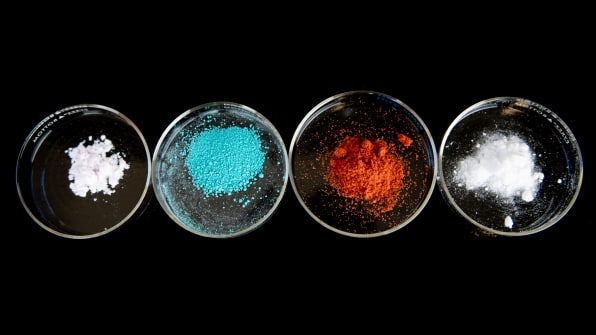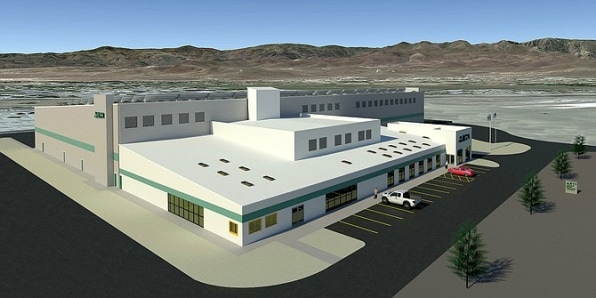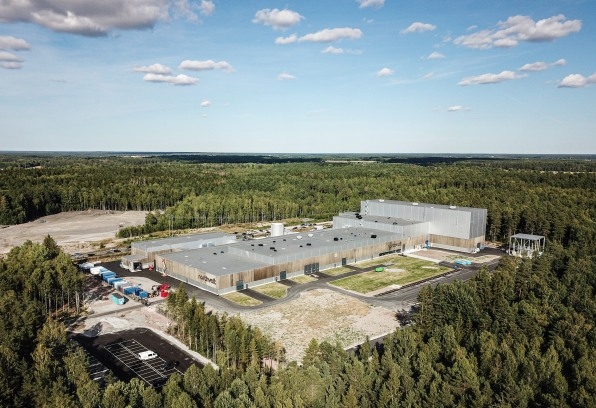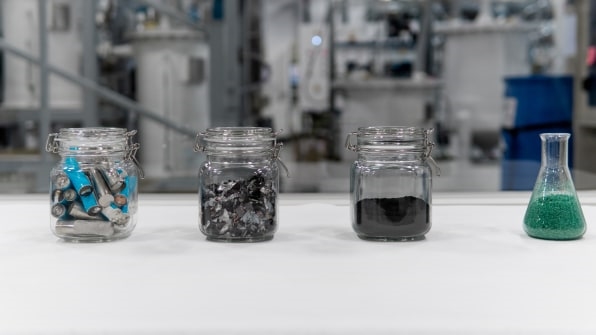Six years ago, Ryan Melsert was part of a small team of engineers sitting in a construction trailer in the middle of the desert in Nevada plotting the details of Tesla’s new battery production facility, the Gigafactory. “We were told to essentially design and build the largest factory in the world, to make the lowest-cost batteries in the world, and to do so without consuming any energy,” he says. “It was a really ambitious goal. And we were literally just staring at a patch of dirt.”
As the factory’s first production lines started to come online, making powders and slurries and battery cells and packs, Melsert recognized a challenge for the industry. The Gigafactory did what it set out to do. But making batteries generates waste, like trimmings and defective batteries, and it was hard to find any facilities to recycle that waste, or even just process it so that it would no longer be hazardous.
“We started buying tractor trailers and parking them onsite, and filling these tractor trailers with all different types of waste material, just hoping that at some point somebody would find a way to be able to process it and recycle it and do it in a sustainable and cost-efficient manner,” he says. “But over those first few years, there weren’t many companies who came forward and were able to do it.”

[Photo: courtesy American Battery Technology Company]
The same challenge exists for used batteries that come from electric cars and from consumer electronics, from smartphones to laptops. The amount of lithium-ion battery waste is quickly growing. But traditional recyclers aren’t equipped to handle it well. It can be dangerous: This summer, for example, a fire broke out at a warehouse storing an estimated 100 tons of lithium-ion batteries, burning for nearly a week and forcing thousands of people to evacuate the area.
Even when batteries don’t burn, the recycling process can release plumes of toxic pollution. And the traditional process is inefficient, so it creates a lot of waste. It’s also so expensive that recyclers often have to be paid to do the work, rather than being able to buy the waste themselves and profit. Moving around huge EV batteries, which weigh hundreds of pounds, can cost more than the value of the materials recovered in traditional recycling. Melsert decided to leave Tesla and start American Battery Technology Company (ABTC) to work on the problem.

The startup is one of a small group of companies now pioneering better battery recycling. Traditional recycling involves shredding batteries and breaking them back down into their elemental parts with heat and chemicals. ABTC wanted to rethink the process based on what the team understood from working on the manufacturing side. “Instead of just taking all of these batteries and putting them in a high-temperature furnace, or putting them into a strong acid bath, or just putting them into a shredder, we intentionally don’t do any of those,” Melsert says. “We back out many of the manufacturing steps in reverse order to ‘de-manufacture’ packs to modules, to cells, to sub-cell components.”
The engineers knew, for example, that it was difficult to get certain powders to stick to metal substrates in manufacturing, or to keep certain liquids inside a battery cell. “All of those failure modes we now intentionally cause during the de-manufacturing process to make these subcomponents essentially fall apart from each other,” he says. After the materials are partially sorted, a chemical process extracts pure materials.
While older recycling methods create lower-grade materials that could be sold to industrial markets, the new process makes them at a quality that can be used in new batteries, fully closing the loop for batteries. (The materials can be used repeatedly through this process with no loss in quality.) By avoiding the high temperatures needed in traditional processes, it also saves energy and cost and avoids air pollution. The process also extracts more materials from each battery, creating little waste.
Right now, very little production of battery materials happens in the U.S.—less than 1% of the total global battery industry, in fact—although domestic battery manufacturing is growing. Tesla’s Gigafactory makes around 38 gigawatt-hours of batteries a year, and more than 400 gigawatt-hours of capacity is under construction in the U.S. Recycling materials closer to battery production could help the supply chain.
In the current system, most of the raw components to make batteries comes from overseas. “Just having to import material that far has a big cost impact,” says Melsert. “There are import tariffs, there are transportation costs. And there’s the security of of supply. As we saw, especially during COVID, during lockdowns, a lot of the global supply chains fell apart, and you physically couldn’t get access to these materials. So if you have a cell manufacturing plant in the U.S., but none of your feedstock is made in the U.S., it makes you vulnerable. And it makes it more expensive to source that material. You also have less visibility into the environmental impact of how those materials were made.”

Other startups are also bringing recycling closer to production, including Northvolt, a sustainability-focused Swedish battery manufacturer, which has raised $6 billion and worked with universities to create another novel battery-recycling process. The company is running a pilot recycling plant now and will begin running a larger plant in early 2023, next door to its battery manufacturing plant, fed with a steady stream of old batteries from places like Norway, where electric cars now outsell fossil-powered cars.
Redwood Materials, run by Tesla cofounder J.B. Straubel, is scaling up battery recycling in the U.S. and plans to manufacture cathodes, the most expensive part of batteries. Redwood’s proprietary process, now in use in a large facility in Nevada, allows it to recover nearly 98% of the rare-earth metals inside a battery. It uses the residual energy inside the battery so that it requires no external energy input.

ABTC is now building its first pilot plant to demonstrate its own process. Through a grant from the Department of Energy and Ford, General Motors, and Stellantis, it will work with the chemical company BASF to show that the recycled material can be made into new battery cathode material. A third partner will make complete battery cells that can be tested for performance against cells made from virgin material. ABTC plans to build its first commercial plant in around two years.
Melsert says that the EV industry will still need to mine new materials as the number of new electric vehicles grows. “Even if you have a 100% perfect recycling system, that can only maintain the amount of batteries in the field,” he says. “As the amount is growing, you need to introduce new material into that closed loop. So the industry needs both recycling and low-environmental impact and low-cost primary metal harvesting.”
ABTC is working on novel methods of mining, as well. The company now owns around 1,000 acres of mining leases in the U.S. and is testing new ways to extract lithium, nickel, and cobalt that have less environmental impact and that can also avoid other problems from other suppliers, such as child labor in cobalt mines. “Recycling technologies are not inherently clean,” he says. “And mining technologies are not inherently dirty.” It’s important that the EV supply chain gets both right: By 2030, the International Energy Agency estimates that there will be as many as 230 million electric vehicles on the road, all in need of materials for new batteries.
(43)